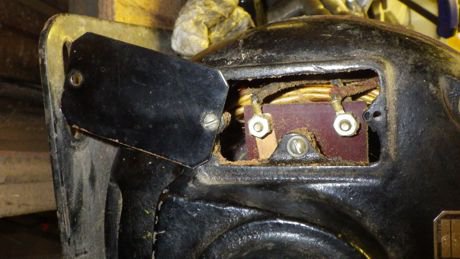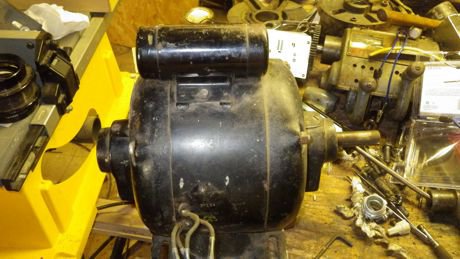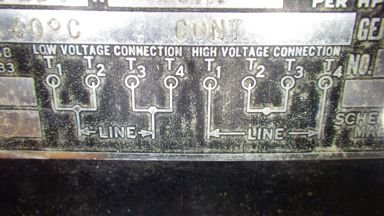I have an old GE 3/4 HP motor model 5KC73AB206A. It's labeled "A-C Motor Dual Voltage Capacitor Induction". It is rated at 10A at 120V and 5A at 240V. It has 4 wires, one bump and bears a wiring diagrams as follows:
Low Voltage
T1 and T2 connected to L1
T3 and T4 connected to L2
High Voltage
T1 wired to L1
T2 and T3 only wired together
T4 wired to L2
I measure low DC resistance (<2 Ohms)continuity between T1 and T3. The same resistance is measured between T2 and T4. I'm assuming these to be the two windings.
I can measure no continuity between any even to odd wires combinations.
Based on these two facts, I assume that it is a split phase motor - one winding between T1 and T3, and another winding between T2 and T4.
When I wire it with the low voltage diagram with AC 120V, it starts and runs fine.
When I remove the voltage, it seems to continue to run for a second before a noticeable abrupt change in RPM.
It also has an unlabeled removable cover with only two terminals underneath.
Here's the confusing part for me: If I try to reverse the rotation by reversing the phase of one of the windings like either of these:
Low Voltage
T1 and T4 connected to L1
T3 and T2 connected to L2
or
Low Voltage
T3 and T2 connected to L1
T1 and T4 connected to L2
... it pops a 20A circuit breaker immediately, with the shaft never even budging.
Is there something wrong with my motor?
Am I doing something wrong?
Is this a type pf motor that just cannot be reversed?
I would really appreciate any advice!
Thanks,
Roger
Low Voltage
T1 and T2 connected to L1
T3 and T4 connected to L2
High Voltage
T1 wired to L1
T2 and T3 only wired together
T4 wired to L2
I measure low DC resistance (<2 Ohms)continuity between T1 and T3. The same resistance is measured between T2 and T4. I'm assuming these to be the two windings.
I can measure no continuity between any even to odd wires combinations.
Based on these two facts, I assume that it is a split phase motor - one winding between T1 and T3, and another winding between T2 and T4.
When I wire it with the low voltage diagram with AC 120V, it starts and runs fine.
When I remove the voltage, it seems to continue to run for a second before a noticeable abrupt change in RPM.
It also has an unlabeled removable cover with only two terminals underneath.
Here's the confusing part for me: If I try to reverse the rotation by reversing the phase of one of the windings like either of these:
Low Voltage
T1 and T4 connected to L1
T3 and T2 connected to L2
or
Low Voltage
T3 and T2 connected to L1
T1 and T4 connected to L2
... it pops a 20A circuit breaker immediately, with the shaft never even budging.
Is there something wrong with my motor?
Am I doing something wrong?
Is this a type pf motor that just cannot be reversed?
I would really appreciate any advice!
Thanks,
Roger




